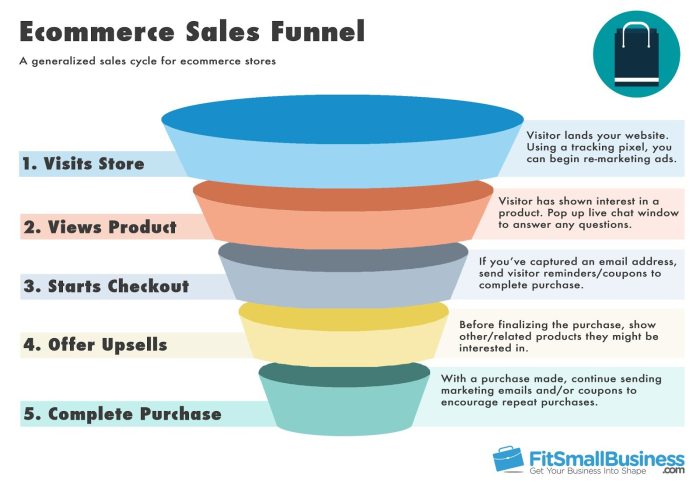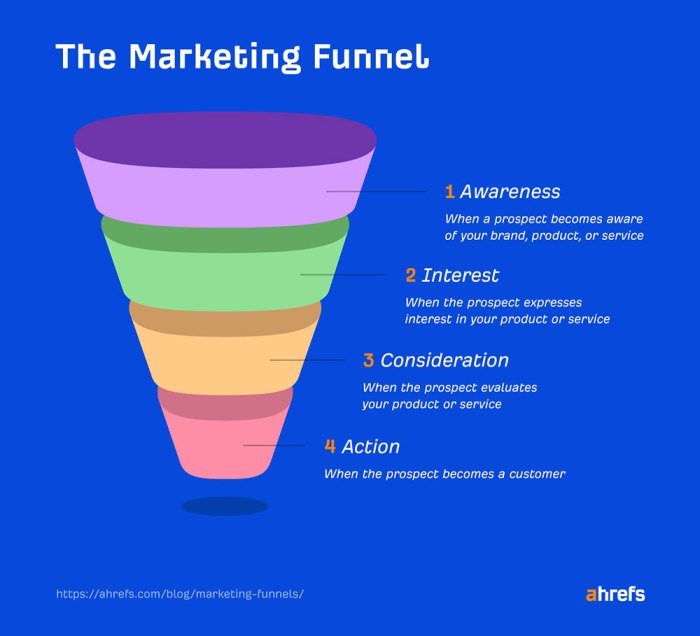Sales Funnel Optimization is the key to unlocking greater success in marketing. By understanding the stages of a sales funnel and leveraging tools and data analysis, businesses can enhance their conversion rates and profitability.
From attracting customers to closing sales, the optimization process is essential for businesses looking to thrive in a competitive market.
Introduction to Sales Funnel Optimization
A sales funnel is a visual representation of the customer journey from awareness to purchase. It includes various stages like awareness, interest, decision, and action. It’s crucial in marketing because it helps businesses understand the customer’s buying process and enables them to tailor their strategies accordingly.
Optimizing a sales funnel is essential for business success as it allows companies to identify and eliminate any bottlenecks or inefficiencies in the conversion process. By streamlining the funnel, businesses can increase conversion rates, improve customer experience, and ultimately drive more sales.
Examples of Successful Companies
- Amazon: By constantly analyzing and optimizing their sales funnel, Amazon has been able to offer personalized recommendations, streamline the checkout process, and enhance the overall shopping experience for customers.
- Zappos: With a focus on customer service and satisfaction, Zappos has optimized their sales funnel to provide a seamless buying journey, resulting in high customer retention and loyalty.
- Netflix: Through data-driven insights and continuous testing, Netflix has optimized their sales funnel to deliver personalized content recommendations, leading to increased subscriber growth and retention.
Stages of a Sales Funnel
In a typical sales funnel, there are four main stages that a potential customer goes through: Awareness, Interest, Decision, and Action. Each stage plays a crucial role in guiding leads towards making a purchase.
Awareness Stage
In the Awareness stage, the goal is to attract the attention of potential customers and make them aware of your brand, product, or service. Strategies used at this stage include social media advertising, content marketing, and search engine optimization to increase visibility and reach a wider audience.
Interest Stage
Once leads are aware of your offering, the Interest stage focuses on nurturing their curiosity and keeping them engaged. Email marketing campaigns, webinars, and personalized content can be effective in providing valuable information and building a connection with potential customers.
Yo, have you checked out this dope article on Using Hashtag Strategy on Instagram ? It’s crucial to up your Insta game with the right hashtags to boost your reach and engagement. Whether you’re into fashion, fitness, or food, hashtags can help your posts get noticed by a wider audience. So don’t sleep on this strategy, give it a read and level up your Instagram game!
Decision Stage
During the Decision stage, leads are evaluating their options and deciding whether to make a purchase. Providing case studies, testimonials, and offering free trials can help in building trust and showcasing the value of your product or service, ultimately influencing their decision-making process.
Action Stage, Sales Funnel Optimization
The final stage of the sales funnel is Action, where leads are encouraged to take a specific action, such as making a purchase or signing up for a service. Clear call-to-action buttons, limited-time offers, and personalized recommendations can help in driving conversions and turning leads into customers.
Tools and Technologies for Sales Funnel Optimization

When it comes to optimizing your sales funnel, having the right tools and technologies can make all the difference. These resources can help you track customer interactions, analyze data, and streamline the optimization process.
Customer Relationship Management (CRM) Software
CRM software like Salesforce, HubSpot, and Zoho CRM can play a crucial role in optimizing your sales funnel. These tools allow you to track customer interactions, manage leads, and personalize communication throughout the sales process.
Analytics Platforms
Platforms like Google Analytics, Mixpanel, and Kissmetrics provide valuable insights into how customers are moving through your sales funnel. By analyzing data such as conversion rates, drop-off points, and customer behavior, you can identify areas for improvement and optimize your funnel accordingly.
Automation Tools
Automation tools like Zapier, Marketo, and ActiveCampaign can help streamline the optimization process by automating repetitive tasks and workflows. By setting up automated emails, notifications, and follow-ups, you can ensure that leads are nurtured effectively and efficiently through the sales funnel.
Yo, have you checked out the latest tips on Using Hashtag Strategy on Instagram ? It’s crucial to boost your social media game, especially if you’re trying to build your brand or grow your following. By incorporating the right hashtags, you can reach a wider audience and increase your engagement levels. So don’t sleep on this strategy, fam!
Data Analysis for Sales Funnel Optimization

Data analysis plays a crucial role in optimizing sales funnels by providing key insights to improve the overall conversion rates and effectiveness of the funnel. By collecting and analyzing the right data, businesses can make informed decisions to enhance their marketing strategies and boost sales.
Types of Data for Analysis
- Customer demographics: Understanding the age, gender, location, and interests of your target audience can help tailor your marketing messages and offers.
- Website traffic: Analyzing website traffic sources, page views, bounce rates, and time spent on site can provide insights into user behavior and preferences.
- Conversion rates: Tracking conversion rates at each stage of the funnel can help identify bottlenecks and areas for improvement.
- Sales data: Analyzing sales data, such as average order value, customer lifetime value, and repeat purchase rates, can help optimize pricing and product offerings.
Key Metrics to Monitor
- Lead generation stage: Key metrics to monitor include website traffic, lead capture rate, and lead quality score.
- Lead nurturing stage: Metrics to track include email open rates, click-through rates, and engagement with content.
- Conversion stage: Key metrics include conversion rate, average deal size, and sales cycle length.
- Retention stage: Metrics to monitor include customer retention rate, churn rate, and customer satisfaction scores.
Data-Driven Decisions for Optimization
By analyzing data, businesses can make informed decisions to optimize their sales funnels. For example, if data reveals a high bounce rate on a particular landing page, businesses can redesign the page to improve user experience and engagement. Similarly, analyzing conversion rates can help identify the most effective marketing channels and campaigns, allowing businesses to allocate resources more efficiently. Overall, data-driven decisions enable businesses to continuously improve their sales funnels and drive better results.
A/B Testing and Experimentation
A/B testing is a crucial method used in optimizing sales funnels by comparing two versions of a webpage or element to see which one performs better in terms of conversions. It involves splitting the traffic between the two versions and analyzing the results to make data-driven decisions for improving the funnel.
Best Practices for A/B Testing
- Clearly define the goal of the test to focus on specific metrics like click-through rates, conversion rates, or revenue.
- Test one element at a time to accurately determine what caused the change in performance.
- Ensure a large enough sample size to make statistically significant conclusions.
- Randomly assign users to each variant to avoid bias in the results.
- Monitor the test regularly and for a sufficient duration to gather reliable data.
Experimentation for Insights
Experimentation goes beyond A/B testing by exploring different ideas and hypotheses to uncover valuable insights for improving conversion rates. It involves trying out new strategies, designs, or messaging to see how they impact user behavior and engagement along the funnel.